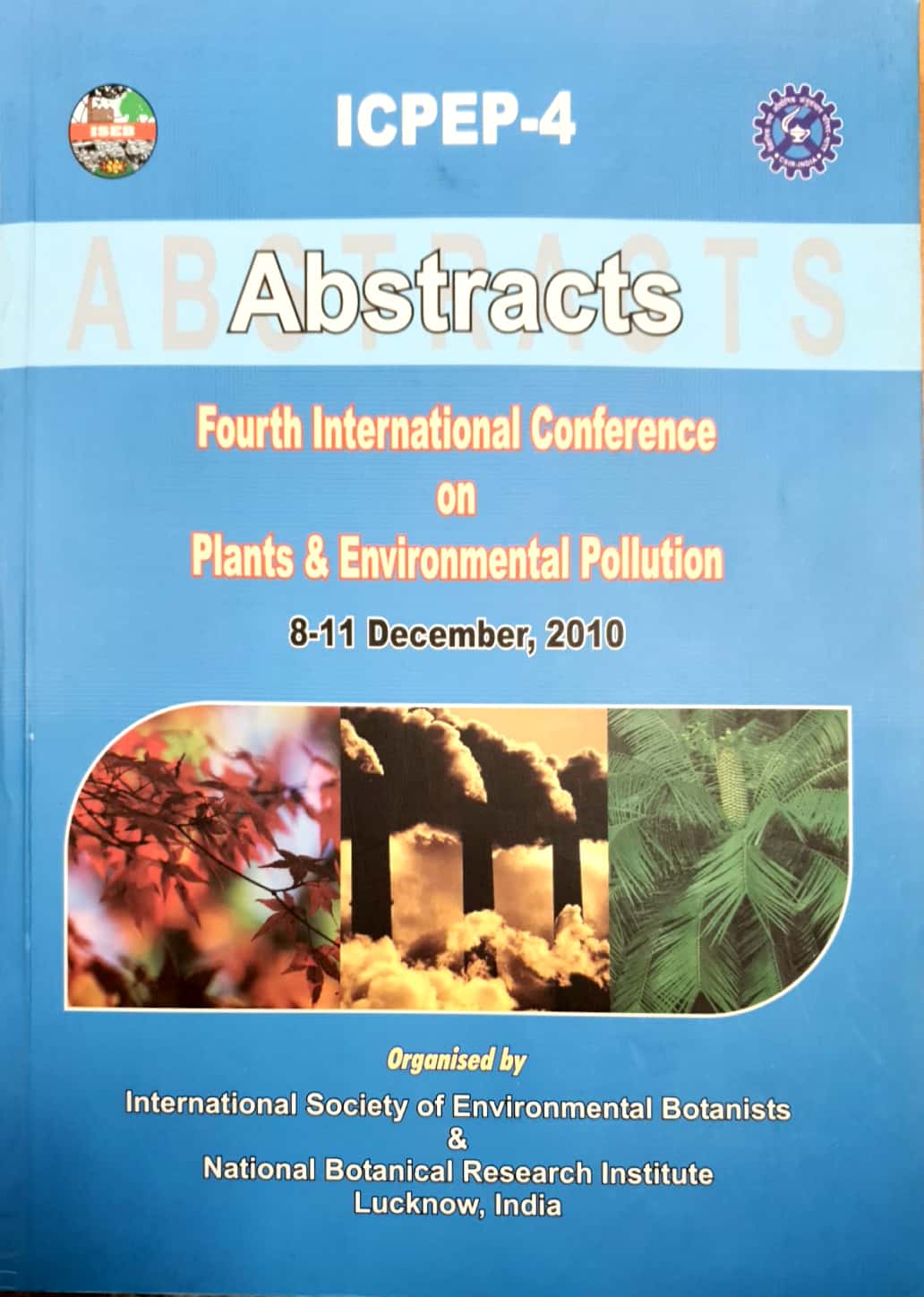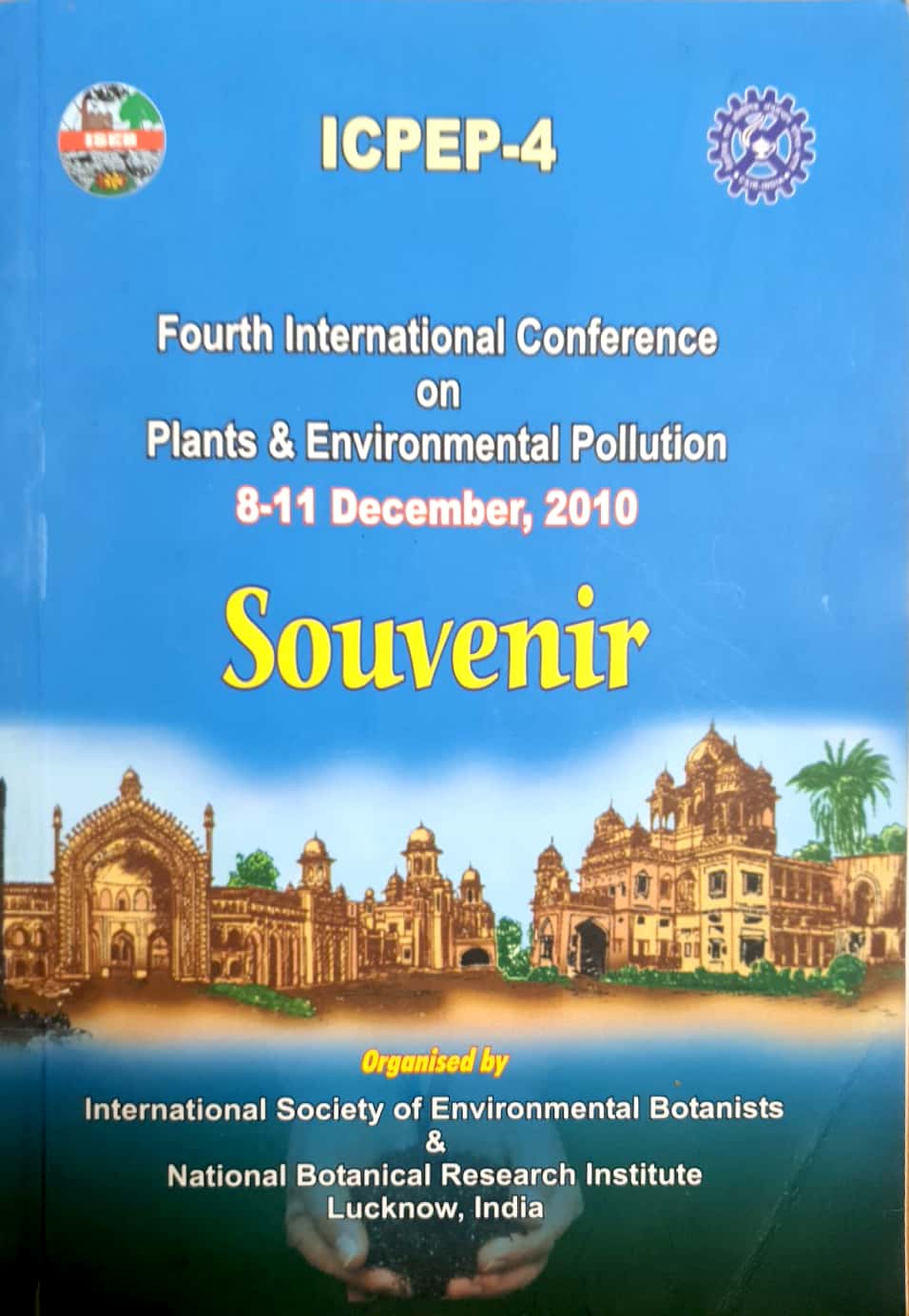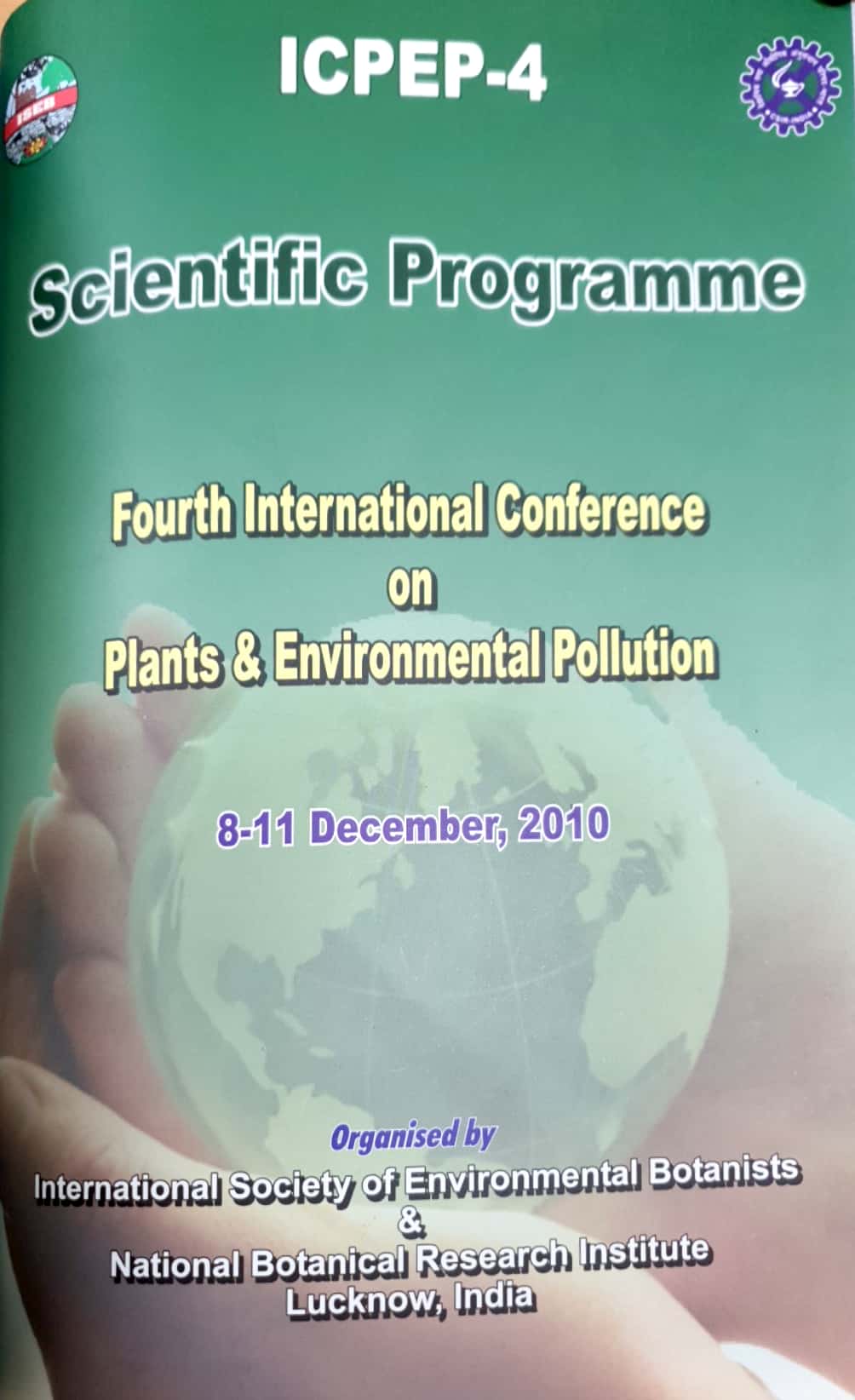Fourth International Conference on Plant and Environment
(ICPEP-4)
(08-11 December, 2010)
Technological progress facilitated by super efficiency of business practices has become one the main causes of serious determination of Natural Resources. At the same time, development of natural sciences lead to the better understating of negative effects produced by pollution on the environment. Environmental pollution is a problem both in developed and developing countries. Factors such as population growth and urbanization invariably place greater demands on the planet and stretch the use of natural resources to the maximum. The transboundary nature of environmental pollution makes it even more difficult to manage.

Looking at the magnamity of the issue and to seek some possible solutions, led for organizing the Fourth International Conference on Plants and Environment Pollution (ICPEP-4). The Conference was jointly organized by International Society of Botanists (ISEB) and National Botanical Research Institute (NBRI) from 8th to 11th December, 2010 at NBRI, Lucknow, India.
The conference was formally inaugurated by Dr. Ram Rajshekran, Director, Central Institute of Medicinal and Aromatic Plants, Lucknow, in the presence of over 600 delegates from India, U.S.A., Japan, Philippines, Chile, Iran, Israel, Australia, Denmark, Poland, Hungry, Bostwana, Nigeria, Indonesia, Mauritius, Taiwan, Italy, Thailand and China. Dr. C.S. Nautiyal, Director NBRI and President ISEB, presided over the function and welcomed the guests and delegates.
On this occasion, Dr. P.V. Sane, former Director of NBRI and founder president of ISEB, and Prof. Sagar V. Krupa, Professor Emeritus at the University of Minnesota, USA and Advisor ISEB, briefly addressed the delegates and conveyed their blessing to ISEB, ICPEP-4 and NBRI. Dr. K.J. Ahmad, Secretary ISEB, and Organizing Secretary, ICPEP-4, explained the genesis of ISEB and ICPEP. The inaugural address by the Chief guest, Dr. Ram Rajasekharan was a scholarly talk on lipid metabolism in plants.


The conference provided a vibrant forum for serious debation on the pressing problems of pollution and the role of plants. The issues were focused on global climate change, fresh water, dwindling forests, biodiversity losses, GM food, emergent ecological disturbances on plants, environmental issues and other factors in environment and plant relation.


The deliberations during the conference revolved around the following themes:
- Climate Change
- Environment and Biodiversity
- Environmental Biotechnology
- Plant Response to Environmental Pollution
- Environmental Impact Assessment
- Bioindication and Bioremediation
- Plant Microbe Interaction
- Waste/water Management
- Environmental Issues
The keynote lectures were given by Dr. P. Pushpangadan, former Director of NBRI and presently Director General of Amity Institute for Herbal and Biotech Products Development, Thiruvanathapuram and Prof. Viney P. Aneja, Head, Deptt. of Marine Earth and Atmospheric Sciences, North Carolina State University, USA. Prof. Pushpangadan emphasized the impact of climate change on Biodiversity with special reference to medicinal plants. He reported how the disturbances in seasonal cues has shown striking variation in phonological events like vegetation pattern, phenology and distribution which is effecting harvester’s and cultivator’s requirements


and condition to grow/collect medicinal plant species. Prof. Aneja discussed impact of agricultural emissions on human and regional health. He deliberated how agri-emissions vary in space and time and how they interact within the various processes and media. According to him the research priorities include the quantification of point and non-point sources, the biosphere-atmosphere exchange of ammonia, reduced sulphur compounds, volatile organic compounds, greenhouse gases, odours and pathogens, the quantification of landscape processes and the primary and secondary emissions of particulate matter.
The session on “Climate Change” dealt with the issue of deteriorating air quality and changing climate and its impact on different Ecosystems. Emphasis was on changing scenario in agriculture, forest, grassland and aquatic system and assessment of carbon stock in plants and soil. Quite a few presentations were on the impact on biodiversity and the methods to mitigate the effect of climate change.



The lectures in the session on “Environment and Biodiversity” mentioned the alteration in biodiversity at the local, regional and global scale due to the changing chemical status of the environment. Emission of gases and particulate containing toxic substances adversely affect the vegetation e.g., algae, lichen, ferns, trees etc. and even microbe. Loss in diversity has many unfavourable implications related to biogeochemical cycles. It was clearly emphasized that the current problems of pollution and global climate change is affecting the biodiversity which in turn is affecting the community stability.


A session on “Environmental Biotechnology” was held to understand the genomic basis of the responses and adaptation of plants/ forest trees to climate change and environmental pollution in order to develop and use genetically improved plant varieties and to conserve and sustainable manage well adapted, genetically diverse and healthy plant/forest genetic resources. The highlight of this session was a Panel Discussion on “GM food”, where the panel discussed on the opportunities, effect and challenges of the Genetically Modified (GM) food crops.
The fourth session was on “Plant Response to Environmental Pollution” where talks were focused on the interaction of elevated pollutants in different media and their impacts on plant System.
The session on “Environmental Impact Assessment” dealt with the assessment of environmental Impact on the Ecological integrity of water, soil and air environment and their effect on the Biological System. Discussions were also on the beneficial and deleterious, characters of pollutants coupled with local and regional meteorological variables.


In session dealing with “Bioindication and Bioremediation” presentation discussed the how plants like algae, lichen, mosses, soil and microflora, ferns, as well as the plant parts (leaf, pollen), and even enzymes can be used for biomonitoring air, water and soil pollution. This session also highlighted the phytoremediation and bioremediation capacity of different plants and microbes, which could be used for remediation of pollutants especially metals/metalloids.
The seventh session was “Plant Microbe Interaction” emphasizing the role of microbes in the changing environmental conditions. Interesting was to know that Escherichia coli a known pathogen may be a natural plant growth promoting soil bacterium. Deliberations were also on the importance of microbes in biodegradation of difficult to degrade pollutants like metal, pesticide and other agro chemicals.
In the “Waste/ Water Management” session the lectures dealt with the eco-technologies for waste and water management through plant system. Deliberations were also on the eco friendly methodologies of recycling the municipal and hospital solid waste.
The session “Environmental Issues” took up the matters related to importance of ecosystem services, environmental education, development of eco-friendly technologies, disaster management, biofuels, biopesticides etc. Presentations were also on the Legislations and Policy for sustainable development. Role of mass-Media in generating environmental literacy among masses was also discussed.
A valedictory function was organized after the scientific session on the afternoon of 11th December, 2010 where in Dr. C.S. Nautiyal, Dr. P.V. Sane, Dr. K.J. Ahmad, Prof. S.V. Krupa and some of the participants expressed their views about the outcome of the conference. Conference recommendations compiled by the Apex and Advisory Committee was read by Prof. Krupa and finalized by taking inputs from the delegates.



ICPEP-4 RECOMMENDATIONS:
- There is a need to identify: (a) the key and emerging areas of the environmental concern associated with the mission of ISEB, and (b) recognize the leading scientists internationally in the areas of present and predicted future concerns, establish a linkage of communication and cooperation and seek their advice on a regular basis.
- There is a need to emphasize environmental education and outreach at the local level by providing the required scientific communication with: (a) the public media, in particular as it relates to both urban and rural communities, and (b) informal and formal education at all levels ranging from young children to post-graduate students at the college level.
- There is a need to highlight the benefits of “traditional knowledge” by the exchange of ideas, for example through EnviroNews.
- There is a need to create opportunities for better interactions among students attending the conference (perhaps a student discussion session to share their academic experiences).
- There is a need for the continued development of modern methods of plant production as it relates to environmental pollution and communicating their advances and application to the user community, the rural population.
- There is a need to actively sustain the very important and effective role that ISEB and ICPEPs have played in environmental conservation in India and other developing countries. Such an objective can be achieved in the future by the responsive and close collaboration of emerging younger generation of scientists at NBRI and other institutions dedicated to the mission of ISEB, with the guidance of senior scholars that have been so successful in making ISEB recognized internationally.
- There is a need to initiate and organize the quadrennial ICPEP (ICPEP-5) in 2015 to maintain continuity, transfer and exchange of knowledge with the associated scientific and user community as they evolve.







